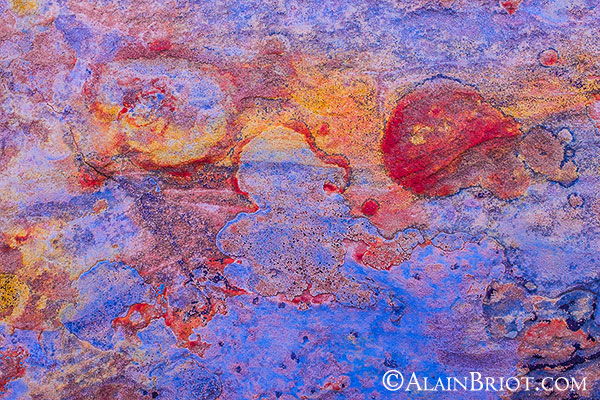

Do not copy nature too much. Art is an abstraction.
Paul Gauguin
1 – Introduction
In this essay, part three of a four parts series about creating abstract photographs, I want to take a look at the different goals we can have for creating photographs. The purpose of this endeavor is to bring clarity to our motivation as photographers and to outline the differences between abstract and documentary images.
2 – What Is Our Goal When Creating Photographs?
I see four main goals for creating photographs. The reason we create photographs can be to:
1 – Document the subject
2 – Capture an expressive or emotional moment
3 – Create artistic photographs
4 – Create abstract photographs
Let’s see what these four categories consist of.
3 – Document The Subject
Documenting the subject means taking photographs that show the subject as it is, the way it looks to anyone that sees it. No attempt is made to use a dramatic quality of light or composition. There is nothing remarkable about the image except the subject although this is not always the case.
It is safe to say that the vast majority of photographers start their career by creating documentary images. This is not surprising because a camera is a recording device. Therefore, if used casually it will record things as they are, without any trace of the photographer’s personality or vision. This in fact, is the definition of documentation: to photograph things as they are without a trace of the photographer’s personality.
Most of the work involved in creating documentary photographs takes place in the field. Studio work is minimal. Image processing is limited to getting the color balance and the contrast correct and does not go past the creation of a technically correct image. No artistic effects are used. The colors in the image are kept natural, no elements are added or removed and no distortion, warping, stretching, collaging, texturing or other effects are used. Finally, the image format is not modified. In other words the image is not cropped or resized. If the image is captured in 35mm format full frame, it will be shown in 35mm format full frame.
Documentary images are not always printed. Their final destination is often a cell phone, a tablet, a computer or a TV monitor. When they are printed print quality is not a major concern, if it is a concern at all. Documentary images are also rarely displayed in shows, museums or other fine art outlets. Their visibility is usually limited to screen devices or to media outlets, be they screen or print based.
The goal of a documentary photograph is to capture the subject as it is without imposing the photographer’s personal take on the subject. A documentary photograph does not show the photographer’s personal style and makes no attempt at expressing an emotional response to the subject.
Its legitimacy lies in faithfully representing the subject without any modifications beyond what the camera captured.
Risk and Solution
The risk is to believe you are creating expressive images while you are actually creating documentary images. The solution is to know what an expressive image consists of (see below) and to make sure that your photographs have or do not have these qualities, as the case might be. If they do not have the qualities of an expressive image, you do have a documentary photograph. If they do have them, you do not have a documentary photograph.

While pleasing to look at this photograph is a literal documentation of the scene photographed. No attempt was made to modify it in any way. The intent of this image is to show things as they are. It is not intended to convey a specific message or to generate an emotional response from the viewer.
4 – Capture An Expressive or Emotional Moment
Creating photographs that capture a moment in time, either expressive or emotional, means focusing on the subject as it is and on its natural qualities. Often, dramatic light such as sunrise or sunset light is used. The photographer may also take advantage of storm light because of its dramatic quality or of other uncommon lighting situations or natural events such as light shafts, rainbows, reflected light and so on. Often, when trying to capture an expressive or emotional moment, hours or days are spent waiting for the desired lighting conditions.
When working in the field a lot of effort goes into the composition of the image. The photographer may spend a lot of time looking for the best location, for a dramatic setting, for an uncommon viewpoint, or for a particularly interesting foreground element. Rules of composition may be applied and lenses such as extreme wide angles, telephoto, tilt-shift or other may be used.
When working in the studio image processing is extensive and deliberate, the primary goal being to achieve the finest image quality possible in order to create a fine art print. When working towards this goal getting a technically perfect photograph is only a start. Therefore the processing extends to artistic modifications such as global and local color and contrast optimization, dodging and burning, cropping and more.
It is important to note that while sophisticated image processing techniques are used, the goal is not to manipulate the contents of the image. Rather, the goal is to generate an emotional response to the image by creating beautiful tonalities and compositions. The goal is not to add or remove elements, distort the shape of objects, warp the image, stretch it horizontally or vertically, or conduct any of the myriad of digital manipulations that are available.
Images that capture an expressive or emotional moment are often printed because print quality is one of their main sources of interest. As a result, a considerable amount of work and expense goes into preparing the print file and making the print. These photographs are often mounted, framed and displayed as wall art and sold as fine art photographs.
The goal of capturing an expressive or emotional moment is to create images that express a sense of place and that express how the photographer felt about the subject. The photographer’s personal style is visible in the image and the photograph demonstrates a definite attempt at expressing an emotional response to the subject.
The legitimacy of the image lies in being faithful to the subject while expressing a personal vision and a personal style.
Risk and Solution
The risk is documenting the moment rather than creating images that express an emotion. The solution is to capture elusive moments, search for unique subjects and visually emphasize your personal style.
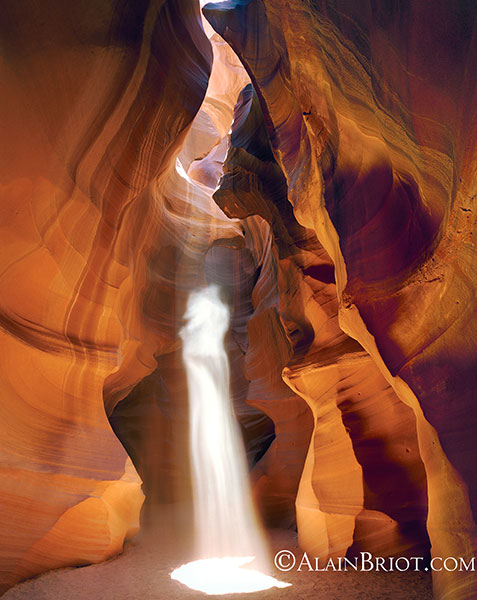
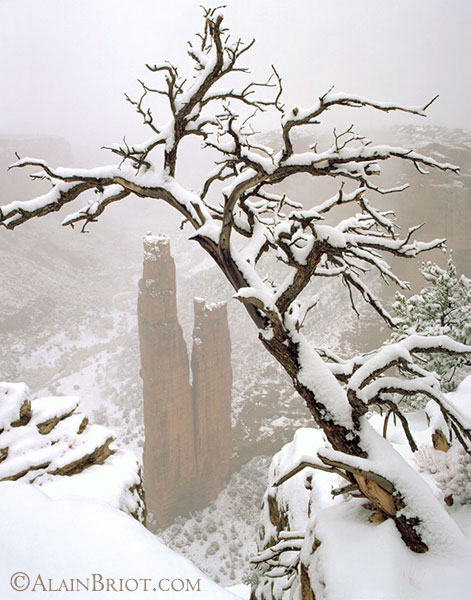
5 – Create Artistic Photographs
Creating artistic photographs means creating images that are interpretations of reality, not documentations of reality. Practitioners of this approach often call themselves artists. The goal of these images is to show the artist’s perception of reality and express their emotional response to the scenes and subjects they photograph.
When working with digital photography the creation of artistic images takes place as much in the field as in the studio. Often, half of the time is spent doing field work and half of the time is spent doing studio work. In the field, all the techniques used to create images that capture an expressive or emotional moment are used. In that respect this aspect of creating artistic photographs is therefore comparable to creating photographs that capture an expressive or emotional moment.
However where these two approaches differ is when techniques whose goal is to take the image into a purely artistic direction are used. These techniques include using uncommon lenses such as the Lensbaby, a diversity of creative filters and any other accessory or technique that provides artistic effects.
In the studio, the image is subjected to extensive processing well past the technical stage. All the possibilities offered by digital imaging are fair game when the goal is to create artistic photographs.
Artistic photographs are often printed because one of their main purposes is to be displayed as wall art either in shows or in museums, galleries, homes or offices.
The goal of creating artistic images is to express the artist’s vision and personal style. It is also to make an artistic statement, whatever that may be. This statement varies from artist to artist and this endless variation is what makes art fascinating to study, enjoy and collect.
To seek a relationship between an artistic photograph and the original subject of the photograph is to misunderstand the purpose of art. To be disappointed because this relationship does not exist is equally misplaced. An artistic photograph, or any work of art for that matter, is not bound to maintain a connection between reality and representation. In fact, it rarely does. Instead, an artistic image depicts a unique reality, one that exists only in the artist’s mind and in the artwork created by this artist.
The image’s legitimacy lies in the artist placing no limits on what he can do in his work. This legitimacy does not lie on being faithful to reality or to the original subject.
Risk and Solution
The risk is creating images that viewers do not understand. The solution is taking the time to explain your work to your audience to make it clear that your goal is to create artistic images and not represent reality in a factual manner. You can do this by writing essays and artist statements, having a blog, making audio and video recordings, giving presentations, teaching and so on.
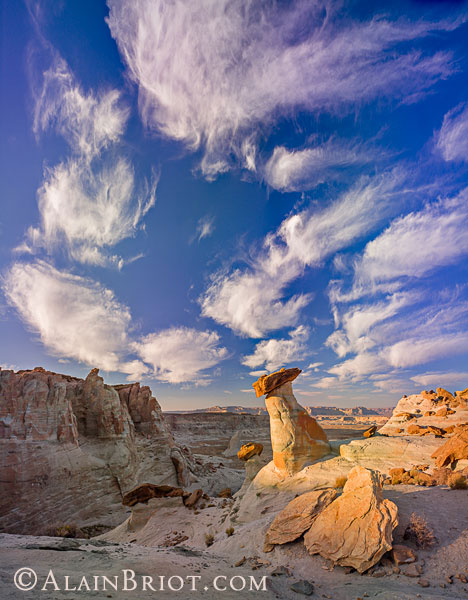
While it may look natural, this photograph was heavily manipulated in Photoshop. The colors were enhanced, the contrast reduced and unwanted elements were cloned out. In addition, the image was originally captured as a horizontal. It was turned into a vertical by stretching it vertically in order to exaggerate the size of the clouds and the hoodoo.
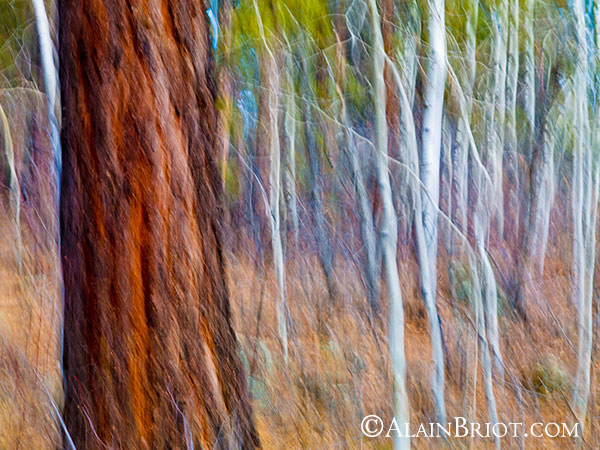
Artistic photographs can also be created by means other than digital manipulation. In this second example, the camera was moved vertically during exposure to create a unique visual effect.
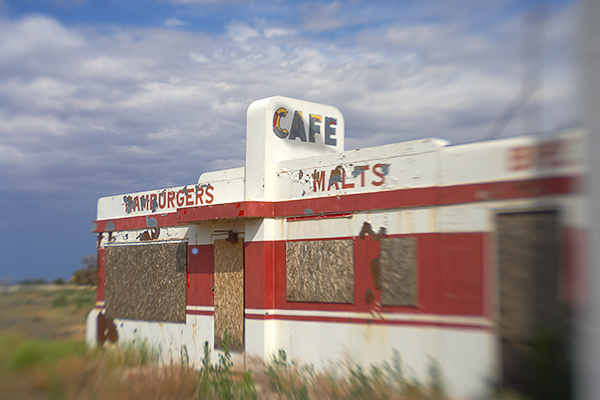
6 – Create Abstract Photographs
Creating abstract photographs means creating images that make no reference to a specific subject or location. Practitioners of this approach call themselves artists because their goal is to create art. The goal of abstract images is to show the artist’s perception of the world and what they see in their mind’s eye. The abstract images they create are a window onto what they see that no one else can see.
The creation of an abstract image starts in the field by selecting the subject and composing the image to remove as much of the context as possible.
This creation continues in the studio by subjecting the image to extensive processing. While the technical aspects are important they are secondary to the artistic aspects. Because there is no direct reference to existing objects or locations there is also no direct reference to ‘ideal’ or ‘perfect’ technical qualities. Perfect technique is what the artist deems acceptable and necessary to express what they have in mind.
Abstract photographs are often printed because their purpose is to be displayed as wall art at shows or in museums, galleries, homes or offices.
Risk and Solution
The risk is similar to that of creating artistic images and in that respect, the solution is the same as the one I outlined above. In addition, the risk is also to address the wrong audience. For example, if you move from creating expressive images to creating abstract images you cannot expect your previous audience to automatically like your new work. They may or they may not.
If they don’t the solution is not to quit creating abstract images because your audience does not understand or like your new work. Abstracts images are complex, intellectually challenging and often go against the aesthetic status quo. These images therefore, demand a higher level of effort and involvement from your audience in order to be appreciated. On the other hand, expressive or emotional landscape photographs are accessible immediately, pleasing to look at and follow accepted aesthetic tenets. If you switch from one genre to the other you cannot force your previous audience to make the effort required to enjoy your new abstract images. No matter how much you would like to change their mind doing so is not within your control. The solution is to find a new audience.

This photograph of a sandstone detail was manipulated to such an extent that the original subject is virtually unrecognizable. The shapes, colors and format of the original capture were so modified that the image no longer bears any resemblance to the original subject. At that point the photograph takes on a meaning of its own. It becomes an abstract image because it is no longer possible to relate it to the original subject.
7 – Different Goals
I want to close this essay with general statements about documentary and abstract photography.
The goal of abstraction is to create originality. It is to show us something new, something we have not seen before the way it is shown to us, or something we have passed by but never noticed.
On the other hand, the goal of documentation is to record things as they are in order to create a visual record of these things. The goal is not to surprise us but but to create a visual catalog so to speak.
In many instances, documentation is more concerned with preserving a visual record than it is with exhibiting this visual record. As a result, a lot of documentary work is filed away rather than exhibited. Many documentary photographs are never seen except by the photographer and the team he or she works with or for.
In comparison one of the purposes of abstract art is to generate surprise and reflection and create a dialogue between artist and audience. As a result, abstract photographs are often shared with an audience through publications or exhibits.
Documentation results in creating a visual copy of the original. Documentation is visual reiteration of the subject through the means used to capture this subject.
Abstraction on the other hand results in creating an interpretation of the original. Rather than reiterate the subject an abstract image creates a new version or a new vision of the subject.
Documentation is real. Abstraction is not real.
The purpose of documentation is to show reality, not to interpret it. The purpose of abstraction is to interpret reality, not show it. Abstraction is therefore the opposite of documentation.
Documentation is concerned with the functional. The whole rather than the parts. The entire subject.
Abstraction is concerned with concepts and ideas, the parts rather than the whole. A piece of the subject.
Successful abstract images are images of the subject that do not give a clue about the subject itself. The simplest way to create an abstract image is to focus on a small part of a large subject. By photographing small areas of the subject we create abstractions by removing context. Instead of showing the entire subject the photograph shows only a piece of the subject.
8 – This Essay Is Continued In Part Four
The next essay will be the fourth and last essay in this series on abstract photographs. In it we will look at at a variety of examples of abstract photographs.
9 – Workshops with Alain and Natalie Briot
If you enjoyed this essay you will enjoy attending a workshop with us. I lead workshops with my wife Natalie to the most photogenic locations in the US Southwest. Our workshops focus on the artistic aspects of photography. While we do teach technique, we do so for the purpose of creating artistic photographs. Our goal is to help you create photographs that you will be proud of and that will be unique to you. The locations we photograph include Navajoland, Antelope Canyon, Monument Valley, Zion, the Grand Canyon and many others. Our workshops listing is available at this link.
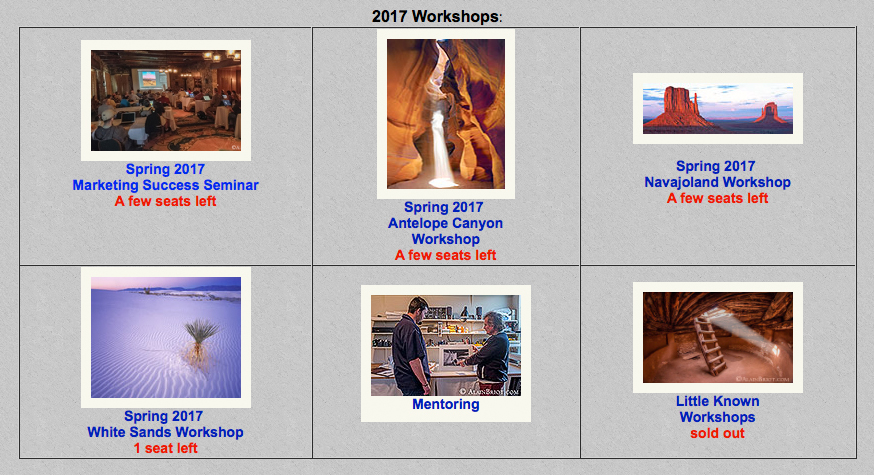
10 – About Alain and Natalie Briot
You can find more information about our workshops, photographs, writings and tutorials as well as subscribe to our Free Monthly Newsletter on our website at http://www.beautiful-landscape.com. You will receive 40 free eBooks when you subscribe to my newsletter.

I create fine art photographs, teach workshops with Natalie and offer Mastery Tutorials on composition, image conversion, optimization, printing, business and marketing. I am the author of Mastering Landscape Photography, Mastering Photographic Composition, Creativity and Personal Style, Marketing Fine Art Photography and How Photographs are Sold. All 4 books are available in eBook format on our website at this link. Free samplers are available so you can see the quality of these books for yourself.
Alain Briot
January 2017
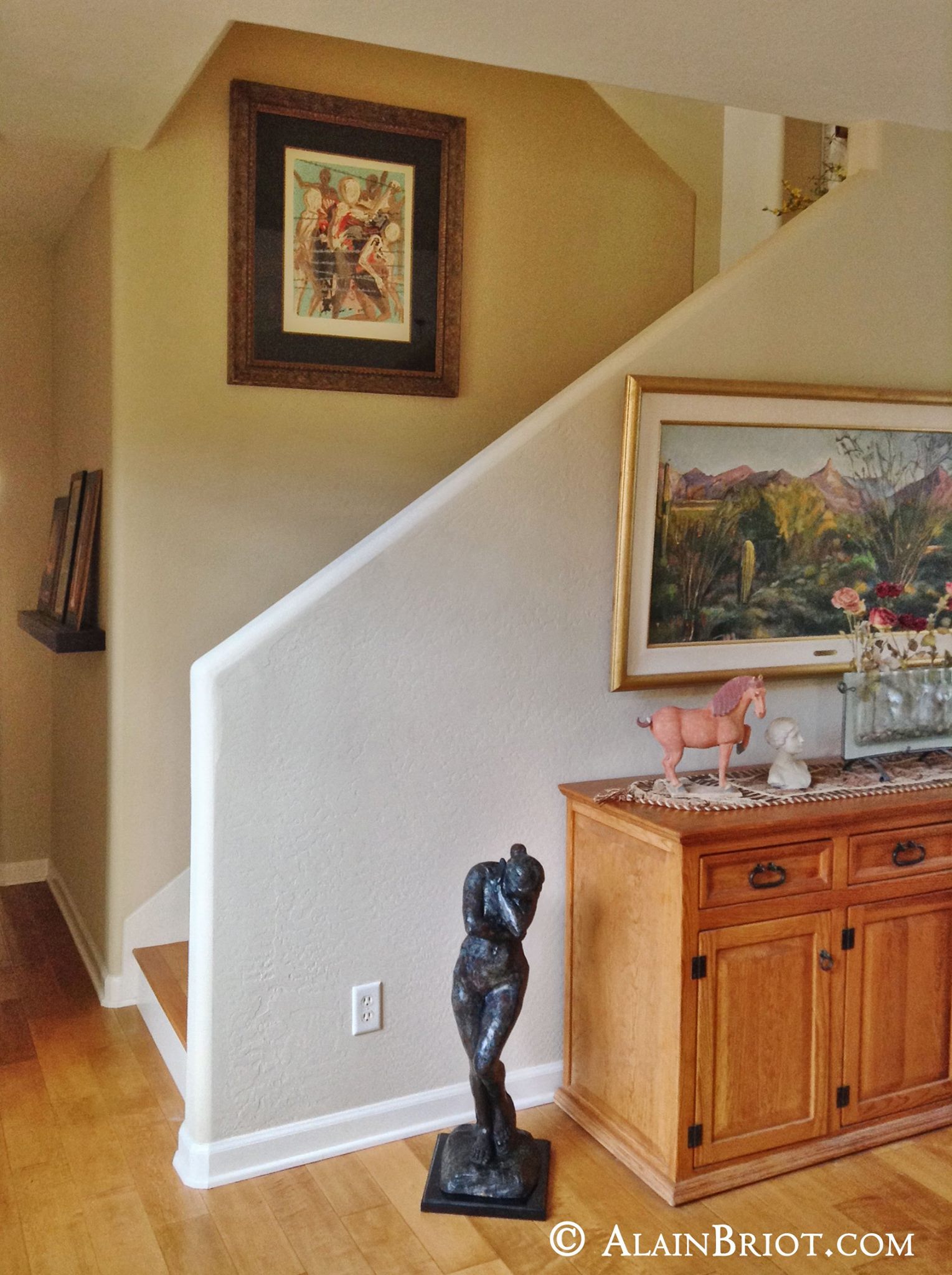
Lorem ipsum dolor sit amet, consectetur adipiscing elit, sed do eiusmod tempor incididunt ut labore et dolore magna aliqua. Ut enim ad minim veniam, quis nostrud exercitation ullamco laboris nisi ut aliquip ex ea commodo consequat. Duis aute irure dolor in reprehenderit in voluptate velit esse cillum dolore eu fugiat nulla pariatur. Excepteur sint occaecat cupidatat non proident, sunt in culpa qui officia deserunt mollit anim id est laborum.
Lorem ipsum dolor sit amet, consectetur adipiscing elit, sed do eiusmod tempor incididunt ut labore et dolore magna aliqua. Ut enim ad minim veniam, quis nostrud exercitation ullamco laboris nisi ut aliquip ex ea commodo consequat. Duis aute irure dolor in reprehenderit in voluptate velit esse cillum dolore eu fugiat nulla pariatur. Excepteur sint occaecat cupidatat non proident, sunt in culpa qui officia deserunt mollit anim id est laborum.
Lorem ipsum dolor sit amet, consectetur adipiscing elit, sed do eiusmod tempor incididunt ut labore et dolore magna aliqua. Ut enim ad minim veniam, quis nostrud exercitation ullamco laboris nisi ut aliquip ex ea commodo consequat. Duis aute irure dolor in reprehenderit in voluptate velit esse cillum dolore eu fugiat nulla pariatur. Excepteur sint occaecat cupidatat non proident, sunt in culpa qui officia deserunt mollit anim id est laborum.
Lorem ipsum dolor sit amet, consectetur adipiscing elit, sed do eiusmod tempor incididunt ut labore et dolore magna aliqua. Ut enim ad minim veniam, quis nostrud exercitation ullamco laboris nisi ut aliquip ex ea commodo consequat. Duis aute irure dolor in reprehenderit in voluptate velit esse cillum dolore eu fugiat nulla pariatur. Excepteur sint occaecat cupidatat non proident, sunt in culpa qui officia deserunt mollit anim id est laborum.

Lorem ipsum dolor sit amet, consectetur adipiscing elit, sed do eiusmod tempor incididunt ut labore et dolore magna aliqua. Ut enim ad minim veniam, quis nostrud exercitation ullamco laboris nisi ut aliquip ex ea commodo consequat. Duis aute irure dolor in reprehenderit in voluptate velit esse cillum dolore eu fugiat nulla pariatur. Excepteur sint occaecat cupidatat non proident, sunt in culpa qui officia deserunt mollit anim id est laborum.
Lorem ipsum dolor sit amet, consectetur adipiscing elit, sed do eiusmod tempor incididunt ut labore et dolore magna aliqua. Ut enim ad minim veniam, quis nostrud exercitation ullamco laboris nisi ut aliquip ex ea commodo consequat. Duis aute irure dolor in reprehenderit in voluptate velit esse cillum dolore eu fugiat nulla pariatur. Excepteur sint occaecat cupidatat non proident, sunt in culpa qui officia deserunt mollit anim id est laborum.

Lorem ipsum dolor sit amet, consectetur adipiscing elit, sed do eiusmod tempor incididunt ut labore et dolore magna aliqua. Ut enim ad minim veniam, quis nostrud exercitation ullamco laboris nisi ut aliquip ex ea commodo consequat. Duis aute irure dolor in reprehenderit in voluptate velit esse cillum dolore eu fugiat nulla pariatur. Excepteur sint occaecat cupidatat non proident, sunt in culpa qui officia deserunt mollit anim id est laborum.

Lorem ipsum dolor sit amet, consectetur adipiscing elit, sed do eiusmod tempor incididunt ut labore et dolore magna aliqua. Ut enim ad minim veniam, quis nostrud exercitation ullamco laboris nisi ut aliquip ex ea commodo consequat. Duis aute irure dolor in reprehenderit in voluptate velit esse cillum dolore eu fugiat nulla pariatur. Excepteur sint occaecat cupidatat non proident, sunt in culpa qui officia deserunt mollit anim id est laborum.

Lorem ipsum dolor sit amet, consectetur adipiscing elit, sed do eiusmod tempor incididunt ut labore et dolore magna aliqua. Ut enim ad minim veniam, quis nostrud exercitation ullamco laboris nisi ut aliquip ex ea commodo consequat. Duis aute irure dolor in reprehenderit in voluptate velit esse cillum dolore eu fugiat nulla pariatur. Excepteur sint occaecat cupidatat non proident, sunt in culpa qui officia deserunt mollit anim id est laborum.
Lorem ipsum dolor sit amet, consectetur adipiscing elit, sed do eiusmod tempor incididunt ut labore et dolore magna aliqua. Ut enim ad minim veniam, quis nostrud exercitation ullamco laboris nisi ut aliquip ex ea commodo consequat. Duis aute irure dolor in reprehenderit in voluptate velit esse cillum dolore eu fugiat nulla pariatur. Excepteur sint occaecat cupidatat non proident, sunt in culpa qui officia deserunt mollit anim id est laborum.
Lorem ipsum dolor sit amet, consectetur adipiscing elit, sed do eiusmod tempor incididunt ut labore et dolore magna aliqua. Ut enim ad minim veniam, quis nostrud exercitation ullamco laboris nisi ut aliquip ex ea commodo consequat. Duis aute irure dolor in reprehenderit in voluptate velit esse cillum dolore eu fugiat nulla pariatur. Excepteur sint occaecat cupidatat non proident, sunt in culpa qui officia deserunt mollit anim id est laborum.
Lorem ipsum dolor sit amet, consectetur adipiscing elit, sed do eiusmod tempor incididunt ut labore et dolore magna aliqua. Ut enim ad minim veniam, quis nostrud exercitation ullamco laboris nisi ut aliquip ex ea commodo consequat. Duis aute irure dolor in reprehenderit in voluptate velit esse cillum dolore eu fugiat nulla pariatur. Excepteur sint occaecat cupidatat non proident, sunt in culpa qui officia deserunt mollit anim id est laborum.

Lorem ipsum dolor sit amet, consectetur adipiscing elit, sed do eiusmod tempor incididunt ut labore et dolore magna aliqua. Ut enim ad minim veniam, quis nostrud exercitation ullamco laboris nisi ut aliquip ex ea commodo consequat. Duis aute irure dolor in reprehenderit in voluptate velit esse cillum dolore eu fugiat nulla pariatur. Excepteur sint occaecat cupidatat non proident, sunt in culpa qui officia deserunt mollit anim id est laborum.

Lorem ipsum dolor sit amet, consectetur adipiscing elit, sed do eiusmod tempor incididunt ut labore et dolore magna aliqua. Ut enim ad minim veniam, quis nostrud exercitation ullamco laboris nisi ut aliquip ex ea commodo consequat. Duis aute irure dolor in reprehenderit in voluptate velit esse cillum dolore eu fugiat nulla pariatur. Excepteur sint occaecat cupidatat non proident, sunt in culpa qui officia deserunt mollit anim id est laborum.
Lorem ipsum dolor sit amet, consectetur adipiscing elit, sed do eiusmod tempor incididunt ut labore et dolore magna aliqua. Ut enim ad minim veniam, quis nostrud exercitation ullamco laboris nisi ut aliquip ex ea commodo consequat. Duis aute irure dolor in reprehenderit in voluptate velit esse cillum dolore eu fugiat nulla pariatur. Excepteur sint occaecat cupidatat non proident, sunt in culpa qui officia deserunt mollit anim id est laborum.
Lorem ipsum dolor sit amet, consectetur adipiscing elit, sed do eiusmod tempor incididunt ut labore et dolore magna aliqua. Ut enim ad minim veniam, quis nostrud exercitation ullamco laboris nisi ut aliquip ex ea commodo consequat. Duis aute irure dolor in reprehenderit in voluptate velit esse cillum dolore eu fugiat nulla pariatur. Excepteur sint occaecat cupidatat non proident, sunt in culpa qui officia deserunt mollit anim id est laborum.

Lorem ipsum dolor sit amet, consectetur adipiscing elit, sed do eiusmod tempor incididunt ut labore et dolore magna aliqua. Ut enim ad minim veniam, quis nostrud exercitation ullamco laboris nisi ut aliquip ex ea commodo consequat. Duis aute irure dolor in reprehenderit in voluptate velit esse cillum dolore eu fugiat nulla pariatur. Excepteur sint occaecat cupidatat non proident, sunt in culpa qui officia deserunt mollit anim id est laborum.

Lorem ipsum dolor sit amet, consectetur adipiscing elit, sed do eiusmod tempor incididunt ut labore et dolore magna aliqua. Ut enim ad minim veniam, quis nostrud exercitation ullamco laboris nisi ut aliquip ex ea commodo consequat. Duis aute irure dolor in reprehenderit in voluptate velit esse cillum dolore eu fugiat nulla pariatur. Excepteur sint occaecat cupidatat non proident, sunt in culpa qui officia deserunt mollit anim id est laborum.
You May Also Enjoy...
Pentax *ist D
This, like many of my equipment reviews is a subjective evaluation based on hands-on experience. I do not detail all of the camera's knobs and
Epson / Snow Leopard Woes
I usually like to work with state of the art tools. Add to that having a teenage son that loves technology, and you will immediately
